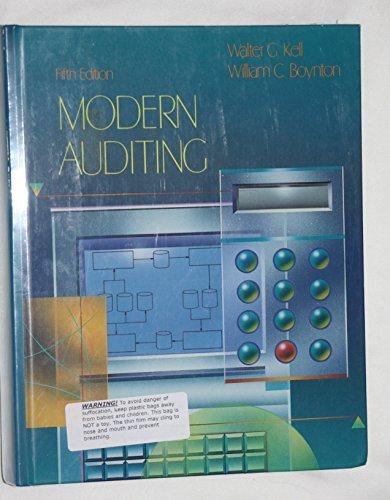Question
SALES OF SECURITIES During the year, Mr. Kupka sold publicly traded securities on the open market in the number of shares, on the dates and
SALES OF SECURITIES
During the year, Mr. Kupka sold publicly traded securities on the open market in
the number of shares, on the dates and for the amounts set forth in the following
table:
Description Date Sold Net Sales
Proceeds
10,000 com shs ABC, Inc 9-25-2022 $322,500
20,000 com shs JKL, Inc 8-26-2022 $240,000
15,000 com shs XYZ, Inc 11-14-2022 $274,000
The shares were acquired by Mr. Kupka in the following manner:
the ABC shares were purchased by Mr. Kupka, and were sold in two 5,000-
share lots. One of the lots was used to cover a "short sale" of 5,000 shares of
ABC stock that Mr. Kupka entered into on 8-28-2022, giving him 30 days to
close.
the JKL shares were purchased by Mr. Kupka on 6-16-2022 for $80,000 plus
convertible debentures.
the XYZ shares were received from Mr. Kupkas grandmother as a result of
her death on 12-30-2021. She originally purchased the shares for $305,000
on 12-17-2021.
More information regarding the transactions:
ABC: With respect to the ABC stock, I shorted 5,000 shares of ABC @ $30/share on 8-28-2022, and covered the short on 9/25/2022 with 5,000 shares of ABC that I acquired on 9/25/2022 at $35 per share. The other lot consisted of 5,000 shares of ABC acquired on 7/10/2020 at $20 per share. They were also sold on 9/25/2022 for $34.50 per share. (Each lot was specifically identified in this manner.) I did not reacquire any ABC shares after the completion of these sales.
JKL: With respect to JKL stock, I purchased four original issue $10,000 JKL debentures on 7-18-2021 for $40,000. The conversion feature allowed me to convert each bond into 5,000 shares of JKL upon surrender of the bond accompanied by a $20,000 payment. On 6-16-2022, I surrendered each bond and paid $20,000 per bond (or a total of $80,000) in return for 20,000 shares of JKL stock 5,000 shares attributable to each bond. At the time of conversion, the 20,000 shares were worth $200,000. I then sold them on 8/26/2022 for $240,000.
XYZ: I received the XYZ shares from Grandma in the form of a testamentary gift. Grandma originally acquired the shares by purchase on 12-17-2021 for a price of $305,000. The shares were left to me through her living trust, and I received them from the trustee on 8/16/2022. The FMV of the XYZ shares on the date of death (12-30-2021) was $255,000. Neither an election under 2032 nor one under 2032A was made in Grandmas estate.
I have a STCL carryover of $5,000 and a LTCL carryover of $16,000.
I like to think of myself as a dealer. I'm not licensed or anything, but I do trade on my own account. I have an active portfolio and I ordinarily make a few trades each year.
Analyze each individual transaction. As part of your analysis, you should perform
each of the following tasks for each transaction:
a) Where appropriate, (hint: the lease to Mr. Ty and the warehouse purchase), determine the true classification of the transaction (i.e., its economic substance) for income tax purposes.
b) Calculate the amount of realized gain or loss respecting each transaction. (That necessarily means you must determine Mr. Kupkas amount realized for each disposition and his adjusted basis in the asset being disposed of. Be sure to calculate depreciation as necessary, and to adjust your basis accordingly.)
c) Determine the amount of recognized gain or loss on
c) Determine the amount of recognized gain or loss on each transaction.(Remember the golden rule: generally realized gain or loss must be recognized unless there is a rule of nonrecognition that applies. The only transaction where nonrecognition comes into play is the exchange between
Mr. Kupka and Ms. Smart. (Dont assume that Mr. Kupka qualifies for nonrecognition treatment. You must explain why he does or doesnt!)
d) Determine the amount of ordinary income generated by the operation of Mimis Furniture & Appliance and the amount of Mr. Kupkas rental income from the warehouse and the lease with Mr. Ty for 2022.
e) Determine the character of recognized gain or loss from each transaction (as (i) ordinary income, (ii) 1231, (iii) STCG/L, (iv) LTCG/L).
f) With respect to any assets Mr. Kupka has acquired in these transactions, determine Mr. Kupkas basis and holding period in the acquired property.
For purposes of your analysis:
Assume that all parties with whom Mr. Kupka dealt are unrelated parties
for income tax purposes unless the facts clearly indicate otherwise.
Assume that Mr. Kupka is a solvent taxpayer.
Calculate any depreciation deduction available to Mr. Kupka where
required for your analysis.
Ignore the impact of 199A.
Ignore the OID rules.
Ignore the impact of California sales taxes.
Step by Step Solution
There are 3 Steps involved in it
Step: 1

Get Instant Access to Expert-Tailored Solutions
See step-by-step solutions with expert insights and AI powered tools for academic success
Step: 2

Step: 3

Ace Your Homework with AI
Get the answers you need in no time with our AI-driven, step-by-step assistance
Get Started


